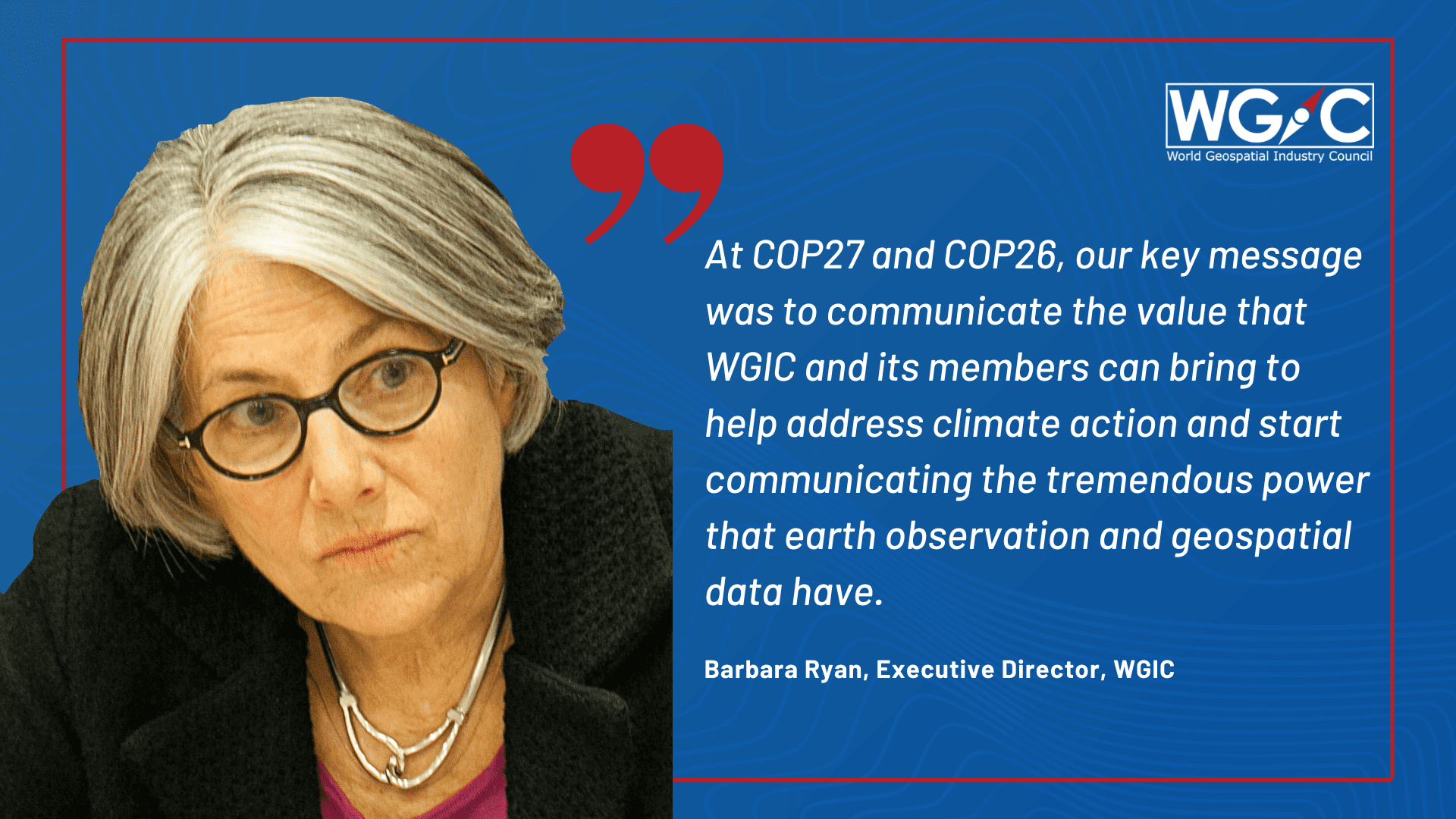WGIC: Barbara, thank you for taking the time to share the details of WGIC’s participation in COP27. Could you please tell us why WGIC picked climate change as a key topic to work on?
Barbara Ryan: To set the context, I want first to highlight that we’re, to the best of my knowledge, the only global trade association that works on behalf of the geospatial and Earth observation (EO) sectors. We are a not-for-profit organization, but one must be a private-sector company working in the geospatial ecosystem to join. During 2020, we chose climate change as one of the core topics to work on, as we saw that the private sector had no representation in global climate policy dialogues, and this was a huge opportunity to make our voices heard. For this reason, the Conference of the Parties (COP) of the United Nations Framework Convention on Climate Change (UNFCCC) became a key avenue to represent the private sector.
Before the start of COP26 in Glasgow, we were approached by the staff of the high-level climate champion Nigel Topping from the United Kingdom (UK) on how the private sector can be a contributor on some of the core issues. To understand the needs of the climate community, we joined hands with Climate TRACE and the Group on Earth Observations (GEO) and organized a high-level dialogue where around 100 climate and geospatial experts came together to identify how earth observation technologies can significantly contribute to this subject. As a result of the dialogue, the three of us put together a research report – “Greenhouse gas Monitoring from Space: A mapping of capabilities across public, private and hybrid missions,” or what I continue to call “a baby step into this area.” The report maps out, and develops a database of greenhouse-gas-detection capabilities across public, private, and hybrid satellite missions.
WGIC: Following the report’s outcomes, what were some of the key messages WGIC delivered at COP26, specifically on private sector capabilities?
Barbara Ryan: The report we came up with was a fascinating study. It showed that historically in space-based EO, the public sector agencies have been what I will call the workhorses. When we look at the 1990s and the 2000s, we start to see the emergence of private-sector companies in that space. As we move into this decade, we see the emergence of what I call true public-private partnerships, where the private sector, public sector, and even some philanthropic organizations come together to launch satellites that observe greenhouse gases from space. Again, it’s a baby step because only three greenhouse gases are recognized by the UNFCCC (carbon dioxide, methane, and nitrous oxide).
Just by coming up with the report and by going to COP26 in the UK last year, we expressed a couple of very simple messages:
- You must continue investing in your public sector agencies. They were here 20 years ago. They’re here now. They’re probably going to be here 20 years from now. They give us wonderful global coverage over long periods. Yet we’re now seeing the private sector coming in with increased spatial, spectral, or temporal resolution.
- If your governments are not leveraging the capabilities of both public and private sector companies, then they are sub-optimizing their climate action or climate solutions. There is a need to put policies that are more conducive to public-private partnerships. We need to work on better access to private sector data.
WGIC: As we can observe, WGIC’s participation in COP26 had a natural continuation in COP27. What kind of role did it play in terms of being nominated for the Prince Talal International Prize?
Barbara Ryan: All those findings presented to COP26 led us to be nominated, by one of our strategic partners, ConnectAID, for Prince Talal International Prize for Human Development, celebrating outstanding efforts towards climate action. WGIC’s project proposal titled “Leveraging Commercial Capabilities for Climate Action on the SDGs through Mapping and Earth Observations” stood out as one of the winners. We received the prize at the recently concluded COP27 in Sharm el-Sheikh, Egypt.
Established by the Arab Gulf Programme for Development (AGFUND) in 1999, the Prince Talal International Prize for Human Development is awarded annually with the aim of inciting and encouraging innovation and creativity in human development. The award enhances development performance and supports key development projects to achieve the goal of sustainability and investment in people.
WGIC:Could you please share the specific objectives you had in your mind as the Executive Director of WGIC when you went to COP27?
Barbara Ryan: First of course, it was visibility and increased awareness of what we can do. In such United Nations entities like UNFCCC, it is almost solely the governments of different countries coming together with international agencies, civil society, and academia. While we’re a narrow part of the private sector, we bring the collective voice of the global geospatial industry to the Conference of Parties and the invaluable offerings the industry has for climate action. I should say that as a not-for-profit organization, it is often easier to access government entities and government processes than any individual private sector company.
Our key message was to communicate the value that WGIC and its members can bring to help address climate action and start communicating the tremendous power that earth observation and geospatial data have. Also, how specific capabilities of the commercial sector can often bring higher-resolution data that could affect people on the ground.
WGIC: As we understand, WGIC members, in their capacity, also participated at COP27. Also, WGIC played a part in bringing them together. Can you tell us more about the objective of the deliberations? What were some of the key messages from the participating members?
Barbara Ryan: I don’t want to say it’s black and white. It is possible for individual private sector companies to participate in the COP. You will see that a substantial part of the financing for the entire event comes from some of the largest enterprise companies. A number of our members were, in fact, present at the event as well.
We leveraged their at a couple of events. The first was with AGFUND, where we accepted the Prince Talal Prize, and then we, together with the other awardees, did a side event talking about what we intend to do with the prize money. It will extend the work we previously did. It will help us to specifically demonstrate the value of offerings from our 35+ members for climate action in Africa.
WGIC: Could you elaborate on the key outcomes of the discussions at the AGFUND and talk about the side event where WGIC members were also present? What were they communicating to the participants?
Barbara Ryan: In the side event we had at the AGFUND pavilion, we were joined by Robert Hoddenbach from Fugro, Stephane Germain from GHGSAT, and Athiye Jawad from Planet Labs.
On behalf of WGIC, I set the context for what we’re going to do with the prize, and each company came in and spoke about their capabilities to address climate action. What was quite important is these were just three of our 35+ members. Each of our members has capabilities to help address climate action. This also was a good move in communicating to the audience that there’s a whole world out there of additional information and capabilities that can affect and address climate action. That was a key output from our AGFUND event.
During the panel discussion, Furgo’s Robert Hoddenbach, highlighted the need to map regions that have not been documented so far because there are still many gaps in our understanding of the impact of, and adaptation to, climate change. Continuing on the importance of mapping to tackle change, Planet’s Athiye Jawad, emphasized on Planet’s mission to image the entire Earth every day. The globally captured earth data will eventually aid in the decision-making especially on climate action making it fact-based thus increasing its efficiency. Talking about GHGSAT’ commitment for climate action, Stephane Germain announced about SPECTRA Premium, a new service to upgrade GHGSAT’s free service and increase access to their data. This highlights GHGSAT’s commitment to continue to contribute their data and efforts to track methane on a global scale, such as the UNEP’s International Methane Emissions Observatory (IMEO).
Some of our members got into partnerships. For example, Microsoft and Planet announced their partnership to apply AI and satellite data to support climate adaptation in Nairobi, Kenya, and Egypt. Planet launched private previews of the Global Renewables Watch, a living atlas of renewable energy powered by Microsoft, Planet, and The Nature Conservancy.
WGIC: Can you elaborate on WGIC’s partnership with the Global Covenant of Mayors for Climate & Energy (GCoM)? How did this relationship evolve, and how did you join hands at COP27?
Barbara Ryan: During 2021, we started a conversation with GCoM. This organization’s 12,600+ signatories representing over 1 billion people demonstrate a commitment to taking climate action.
Our communication with GCoM had the same message: How can geospatial technologies from the private sector enhance actions that cities are taking? These conversations went on for about a year. Then, at the beginning of 2022, we met in Amsterdam and discussed whether we could formalize this partnership and come up with a project or an effort where cities can identify their needs and, while WGIC and its members identify what capabilities we have to address those needs.
As a result, in collaboration with GCoM, we put together a discussion paper that was shared at a side event at COP27 in Sharm el-Sheikh. The side event was well-attended. Robert Hoddenbach from Fugro, represented WGIC. There were government managers and representatives from GCoM and a representative from the financial sector. It showed the power of partnerships. I think it’s very clear that the sum of all these parts creates a significant whole than if you were to look at each of them individually.
Along with GCoM, we will be doing a deeper dive with a couple of cities in 2023. We will bring along with us our members who can help cities gain knowledge on geospatial offerings that can assist in climate action. In that case, this will be a wonderful opportunity to create synergies between the cities and the entire geospatial ecosystem.



